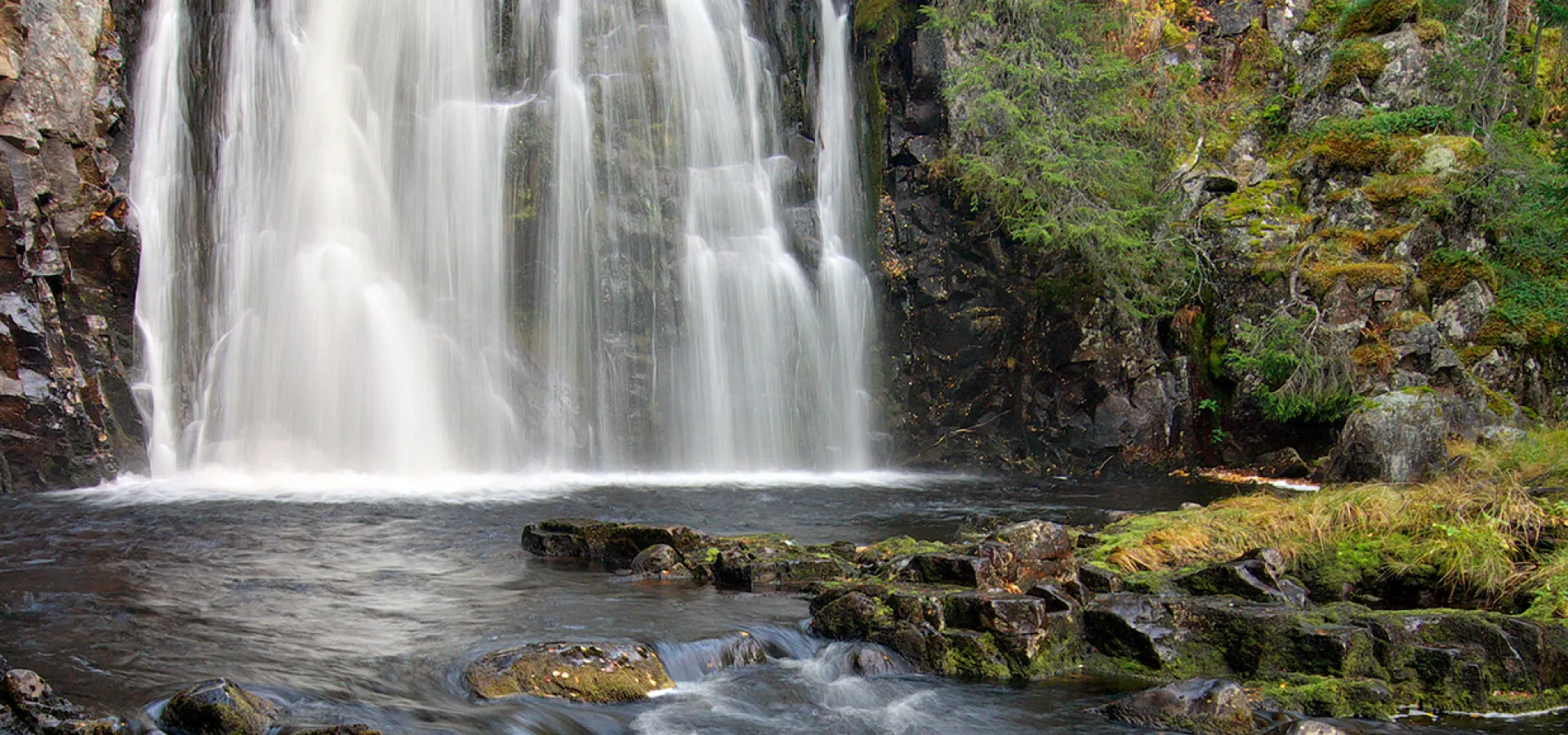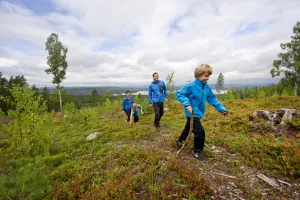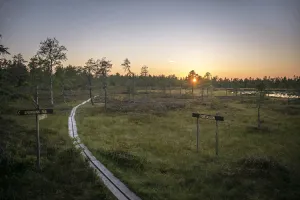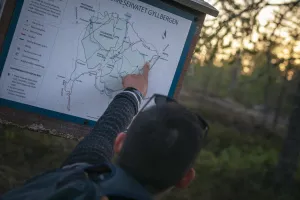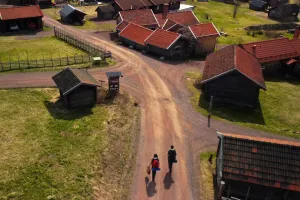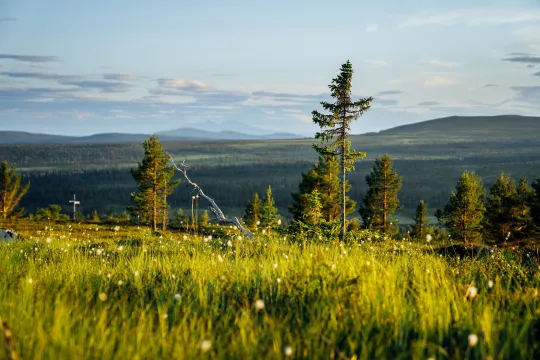There’s something special about standing next to a waterfall. No matter how big or small, seeing the water crashing down is a magical feeling. So get out there and get hunting for the six listed waterfalls in Dalarna. Experience the power of the frothing water and feel the buzz in your belly as you traverse dizzying heights.
1. Styggforsen, Boda
With a drop of 36 metres, steep cliffs and dark pine forests, the frothing falls at Styggforsen add a magical and dramatic atmosphere to your visit. The hiking loop is roughly a kilometre long and takes you over narrow walkways, steps and stairs around the fall. Here, you’ll find hard-to-spot butterflies, rare plants and exciting cultural history to read about on the information boards. Such as the fact that Styggforsen was a filming location for Ingmar Bergman’s 1960 film The Virgin Spring.
It is a unique example of the power of meteorite showers, such as the one that occurred in Siljansbygden around 377 million years ago. Here, you’ll find the 36 metre-high double waterfall and mighty rock faces whose tops are covered with green layers of limestone, sandstone and granite. There used to be several mills in the area, as evidenced by a recently discovered water mills.
A coffee hut open during hiking season is located next to the nature reserve car park.
2. Yxningåfallet, Särna
By the foot of Vedungsfjällen lies the beautiful Yxningåfallet, part of the Fjätälven eco-park. With a drop of around 50 metres, the water cascades down over several levels into the deep, forested ravine.
The way there may be unmarked, so we recommend you take a map and compass. There is a serious climb that you will have to overcome but shame on those who give up! You will get your reward once you reach the top.

3. Njupeskär, Fulufjället national park
The roar of the water as you cross it is almost deafening and creates a dense fog that is extremely useful for a number of unusual mosses and lichen on the slopes. Njupeskär is an easy hike during the summer months. You will walk through magical nature, along the Njupån valley trail, past 400 year-old pines.
With a height of 93 metres, including a 70-metres free fall, Njupeskär is one of Sweden’s highest waterfalls. Leave the Fulufjället nature study centre and follow the Njupeskärsslingan which is 4 kilometres long in total. There is a small rest stop after 1.5 kilometres with a fire area and fantastic views over the waterfall. From here, you can decide if you want to walk up above the waterfall. If you do, follow the path marked “Fallet runt” but please be aware that the path is very steep and stony in some places.
The Njupeskärsslingan takes you to and from the waterfall and offers fairly easy hiking but is not suitable for wheelchairs or buggies. There is an accessible loop trail that starts from the nature study centre and is around 2 kilometres long. At the nature study centre, you can visit an exhibition on the Fulufjället’s flora and fauna, watch a film, follow guided tours and get help with tips for hiking. For the latest opening times and activities, see the Fulufjället nature study centre’s own website and social media.
Please be aware that the area sees a high number of visitors during certain periods and seasons. Please be respectful of other people and nature. Where possible, choose days and times with fewer visitors.
Read more abut Njupeskär and the Fulufjället national park

4. Rotensugnet, Älvdalen
North of Älvdalen lies Rotensugnet, a nature reserve that takes its name from the waterfall which the Rotälven river forms in the area. “Sugn” means waterfall in Elfdalian. In this dramatic landscape, the Rällan cuts through a deep ravine. The Rotälven splutters forth into a small canyon and forms a waterfall, the Rotensugnet, by a fault line just before it joins the Rällan.
Also worth seeing is the old dam wall with flood-gates which once made it possible to transport timber past the waterfall on the log channel. For a great view, follow the path below the Rotensugnet over the Rällan via the footbridge and continue up towards Älåsen. The trail is around three kilometres long.
Please be aware that the Rotensugnet is located within the Älvdalen shooting area so please remember to check that there are no shooting exercises going on in the area when you visit.
Read more about the Rotensugnet

5. Helvetesfallet and Storstupet, Orsa
The Ämån watercourse, the majority of which runs through Orsa municipality, cascades down over a number of waterfalls of varying sizes that are well worth seeing. The most well-known and spectacular are located around 20 kilometres north of Orsa and are called Helvetesfallet and Storstupet. Here, the Ämån has carved down deep into the ground as it rushes through a canyon with a height of 30 metres and steep rock faces.
The Ämån was expanded to create a timber raft in the 1800s to float timber that was felled high up in the forest down to the sawmill. At Storstupet, the waterfall was so high that they had to lay a log channel, the remains of which can still be seen to this day. The Inland Line passes over the railway bridge that was built across the canyon, and in summer passengers on the train get a fantastic view of this dramatic ravine.
Starting from the Skräddar-Djurberga shieling, the 15 kilometre-long hiking trail takes up past Storstupet. If you take a quick detour from your hike and follow the Siljansleden trail for a bit, you will also reach the Helvetesfallet.
Please be aware that the area surrounding the waterfall is very stony and the path leading up to it are steep and difficult to navigate in places. There is a risk of slipping if it has rained and the trail is muddy. Take it slowly, be careful and wear boots or shoes with good grip.
You can read more about Helvetesfallet here and about Storstupet here.
6. Fjätfallen, Särna
Fjätälven is home to two waterfalls, one big and one small, both called Fjätfallen. Three kilometres from Fjätfallen, past the road to Sveg, follow the sign marked “Fjätfallet”. At the end of the path, you can follow the trail down to the water where you will find a powerful waterfall with many drops, the so-called Big Fjätfallet. There is also a great loop trail after the river and a lean-to with views over the waterfall, perfect for a traditional Swedish fika.
Little Fjätfallen is the smaller of the two waterfalls, situated in beautiful surroundings slightly further north, near to Fjätervålen. Here, you will find magnificent waterfalls, and a suspension bridge that you can walk over. Pack a solid picnic with you and get ready for an enjoyable lunch stop. If you manage to tick off both Fjätfallen, you will get to see eight waterfalls on your safari.


